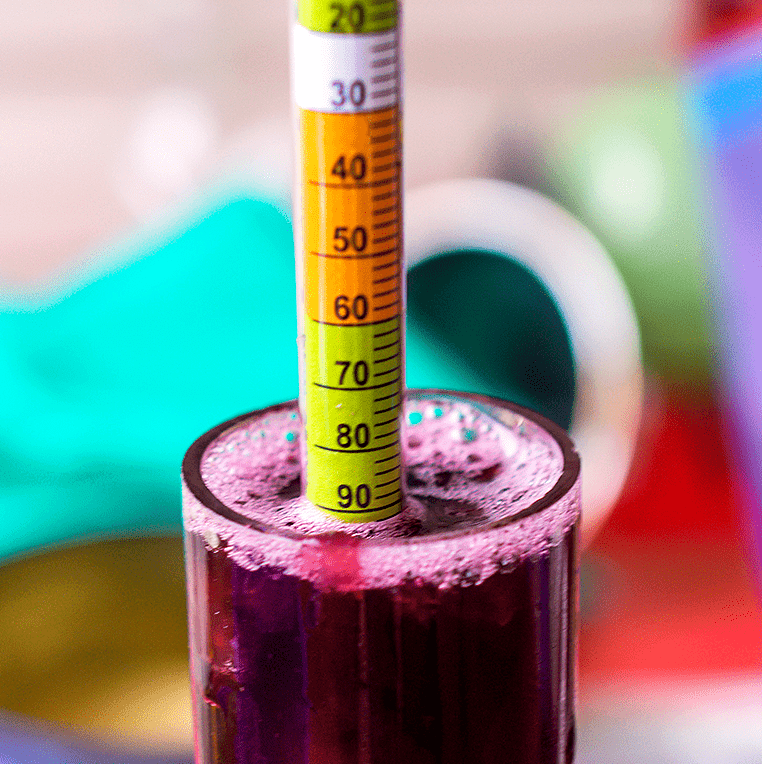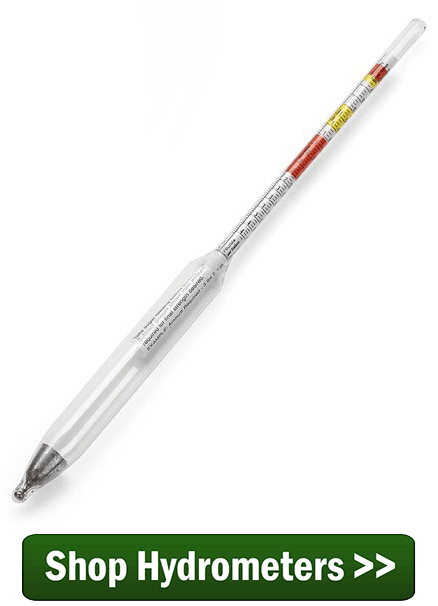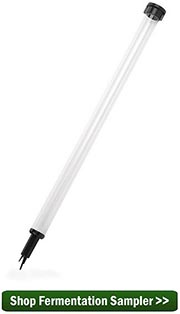 I am using a concentrate that calls for 12 lbs of sugar. I read my hydrometer at 1.140 or 18.5% potential alcohol. Would this be correct or am I ready it wrong? Thanks again, you have a GREAT web site…..
I am using a concentrate that calls for 12 lbs of sugar. I read my hydrometer at 1.140 or 18.5% potential alcohol. Would this be correct or am I ready it wrong? Thanks again, you have a GREAT web site…..
Name: William R.
State: MO
—–
Hello William,
The wine hydrometer reading you provided is too high for a wine. Most wine yeast will have trouble fermenting that much sugar. As a fermentation continues, each additional percentage of alcohol gets harder and harder for the wine yeast to ferment.
A specific gravity reading of 1.140 on a hydrometer does coincide with a potential alcohol of 18.5%, so I do believe that the hydrometer showed this reading, but is it the correct reading? That’s the big question here!
Here’s what I know. If this is a 5 gallon batch and you added 12 pounds of sugar to it. This sugar, by itself, will create a potential alcohol of about 12%. I’m assuming that the directions with the concentrate said this was how much sugar to add. In addition to this, the concentrate will raise the potential alcohol reading even further. Any concentrate is mostly fruit sugars that will contribute to the potential alcohol. I can not tell you exactly how much the concentrate contributes without knowing more about the specific concentrate you are using.
There is also the distinct possibility that you got an incorrect reading, and that’s why the wine hydrometer reading is too high. There are three common ways we see home winemakers get incorrect hydrometer readings:
- Not Enough Wine Sample Was Used
 One requirement for getting an accurate hydrometer readings is the hydrometer has to be floating. That’s what it’s all about, reading how high or low the hydrometer floats. If there is not enough wine to float the hydrometer you will get a reading that is meaningless. The hydrometer has to be off of the bottom.
One requirement for getting an accurate hydrometer readings is the hydrometer has to be floating. That’s what it’s all about, reading how high or low the hydrometer floats. If there is not enough wine to float the hydrometer you will get a reading that is meaningless. The hydrometer has to be off of the bottom.
- The Sugars Did Not Get Evenly Dissolved
The sugar in the wine must is what actually causes the hydrometer to float. The more sugar there is in the wine must, the higher the hydrometer will float. The more sugar there is, the more alcohol that can potentially be made. Sugar is what ferments into alcohol. This is the whole basis of a wine hydrometer. But if the sugar you add is not evenly blended throughout the wine, you will get an incorrect reading. The un-blended sugars drift to the bottom causing samples taken off the bottom through a spigot to be completely different than a reading taken off the top.
- The Calibration Of The Hydrometer Is Off
This doesn’t happen very often, but I have seen it happen once or twice over the years. The scales in a glass hydrometer are on one a piece of paper that is carefully tacked into place with a spot of wax from the inside. If the paper comes loose and the hydrometer is jarred around enough, the paper could slip. An easy way to check your hydrometer’s calibration is to float it in water. You should expect a specific gravity reading of 1.000 at a temperature of 60°F.
 After reviewing the above, if you still determine that your wine hydrometer reading is too high. I would take some measures to lower it. This means diluting the wine must with more water. Shoot for a potential alcohol around 13% or 14%. Use a Champagne type yeast. This wine yeast is able to handle higher amounts of sugar than most.
After reviewing the above, if you still determine that your wine hydrometer reading is too high. I would take some measures to lower it. This means diluting the wine must with more water. Shoot for a potential alcohol around 13% or 14%. Use a Champagne type yeast. This wine yeast is able to handle higher amounts of sugar than most.
WARNING: If the concentrate was packaged specifically for making wine, I doubt that you have an accurate reading, and one of the 3 above reasons are applying. It would be very unusual for a wine concentrate to be off. Not even a little bit. The wine concentrate producers know how to get you exactly to the reading you need simply by following the provided wine recipe. If this is specifically a wine concentrate I would be very hesitant to add any additional water or sugar to the wine must without making sure I got to the bottom of things.
Happy Wine Making,
Ed Kraus
—–
Ed Kraus is a 3rd generation home brewer/winemaker and has been an owner of E. C. Kraus since 1999. He has been helping individuals make better wine and beer for over 25 years.

I have seen more than a few having problems with reading a hydrometer. And when they adjust for temperature they are thinking the room temperature. And that can lead to problems. When adjusting the reading for temperature it should be noted they mean the temperature of the sample being measured. I made this mistake starting out. The instructions just list temperature adjustments. But not where to get the reading from.
I have also found that the bubbles from the fermentation like to stick to the hydrometer causing it to float a little higher. I usually give it a little spin to get the bubbles off. Another problem is if using a graduated cylinder the hydrometer tends to tilt and touch the sides throwing your reading off. I have taken to dropping the hydrometer into the must bucket for the most accurate reading. You have to be careful to keep your hydrometer exceedingly clean or you risk contaminating the entire batch.
I always give my hydrometer a little spin in an attempt to eliminate bubbles from attaching to it. Didn’t think it would give it that much lift. With that much sugar it could be accurate.
Even with recipes I generally add a portion of the sugar, stir and test before adding. I’ve got a published blackberry recipe that calls for 11.25 pounds of sugar for 5 gallon and it generally takes 8-9 pounds to hit the SG.
I ruined my 1st batch of fruit wine because I added the 12 pounds of sugar it called for. I take my hydrometer reading to 1.09 now and it comes out fine. I’d focus more on my wines OG than the amount of sugar… but that’s just me. 🙂
This was very interesting, I don’t know much about hydrometers , because Im from the old school, and never used them. I always get good wine.
I always shoot for 1.140. What can I say, I’m not really a wine drinker but I do like my 18-20% fruit drink on ice !
do you start your juice at 1.140 or do you work your way up through out the fermentation week?
what types of yeast do you use?
Could it be that he added more than 12#’s sugar? Maybe his scale is not accurate!
I have added the filings etc to red wine after day 6 but forgot to check level on hydrometer now it reads 1.020 is this no good now for bottling
The hydrometer reading you have given indicates that the fermentation is not yet complete. You want to see the hydrometer sink a little further. Usually around .998 to .994.
I have made blackcurrant wine. I didn’t take an SG reading at the start (didn’t hav an hydrometer!) but the wine has been racked for 6 months. Have taken a reading today prior to bottling and the reading is 1.052. Should I leave the wine for longer? Silly question; should I have poured the tested wine back into the demi-john and should I top the DJ back up to the neck if I am going to leave it for longer? It seems to me that if you keep testing this way…you end up with no wine. Sorry but this is my first crack at this brewing game!
Helen, before you bottle the wine, the fermentation needs to complete. If the fermentation has not completed in 6 months, there is some type of issue causing this to happen. Please take a look at the article posted below on the most common causes of fermentation failure. As far as taking out samples, you should not be losing that much wine when you take samples for a hydrometer reading. However, you do need keep the volume up to at least the nape of the neck of the demi-john to prevent oxidation. Besides water there are a few different ways to deal with excess head space.Please see the article posted below for more information.
Top Reasons For fermentation Failure
https://eckraus.com/wine-making-failure/
Topping Up Your Homemade Wine
https://eckraus.com/wine-making-topping-up/
My wine seems to be stuck 1056 I have tried moving the wine to different areas in my house but this still will not budge. My SG Was at the highest reading so it has come down about half way but will not move any more, IV tried adding a higher tolerate wine yeast up to 20% but still no movement after 5 dayd
Dave, Have you taken a look at our article on the top reasons for a stuck fermentation? We have listed the article link below? There are several different reasons that can cause this to occur. To correct the situation, you need to find out what caused it to become stuck so I would see if any of the reasons apply to your situation.
Top Reasons For Fermentation Failure
https://eckraus.com/wine-making-failure/